Read the blog
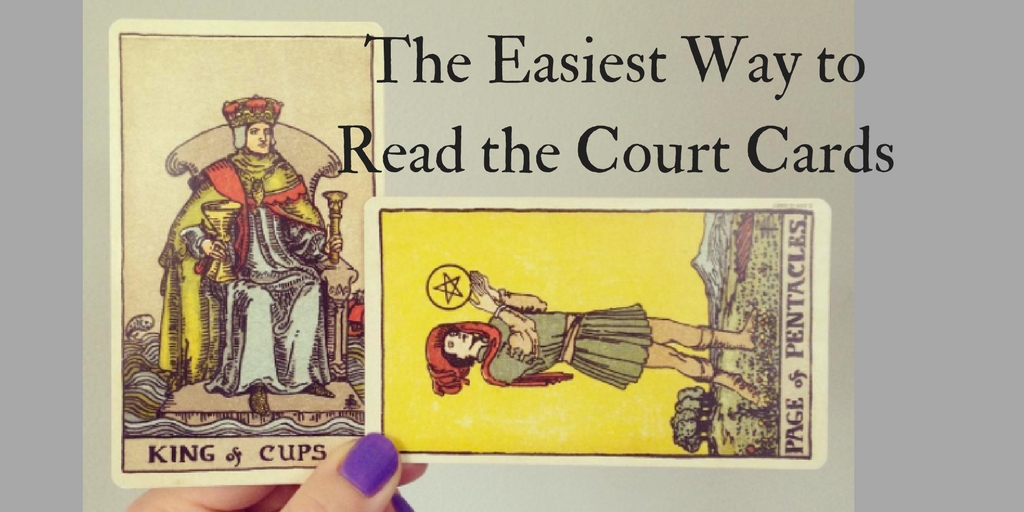
How To Read the Tarot Court Cards (the easiest way)
It’s a pretty common notion that the court cards are the hardest to grasp part of a tarot deck. That’s really saying something when you realize that many of us find the vast archetypes of a nuanced major arcana card like the Tower more accessible than an unassuming little card like the Page of Cups!
The Court cards throw many tarot readers for a loop, so today I’m going to share with you one pretty straightforward and easy way you can improve your understanding of the tarot’s court cards.
Before I get into the heart of this lesson, I want to say that just like with anything else in tarot studies there are many, many different approaches to the court cards. I’m firmly in the camp that there’s no right or wrong way to read tarot. My approach to pretty much anything with tarot is to take some traditional knowledge and blend it with my own personal style, and I think it’s useful to give yourself permission to do the same thing.
That said, when I first started learning tarot, I came across a simple yet really effective framework to understand the court cards. This mainly comes from Joan Bunning’s Learn Tarot course (the entire course is available for free online at learntarot.com). Much of what I’m going to share with you today is based on the framework I learned from Joan’s course.
By reading this article, you’ll gain a greater understanding of how to interpret the court cards in your own way. For additional practice, make sure to download the free worksheet included at the end of this post.
The Whats and Whys of the Court Cards
Let’s start by considering what the court cards really are. Why do they exist, and what do they contribute to the deck as a whole? Put simply, court cards can be thought of as representing either specific people, specific personality traits, or specific approaches to life. Just like real life people, each court card has its own quirks and characteristics – for example, some court cards are outgoing, some are reserved. Some process information analytically, some intuitively.
Psychologists have come up with many different ways of categorizing different personality types – think of the court cards as the tarot deck’s way of doing the same thing. In fact, the popular Myers-Briggs personality indicator defines 16 personality types, and it just so happens there are 16 court cards. Many people have linked up the tarot courts to Meyers-Briggs types, but we won’t go into that here! For now, just consider that when you draw a court card, it can be useful to consider how a specific type of person, or a specific aspect of your own personality, is currently effecting your situation.
How to Interpret the Court Cards
Now that we’ve given some consideration to what the court cards are, let’s dive into a framework for understanding and interpreting them. This framework is based off a simple premise: each court card has a RANK – in most decks the ranks are Page, Knight, Queen and King; and each court card has a SUIT – usually Cups, Pentacles, Wands and Swords. Each rank has its own set of characteristics, as does each suit.
To get a basic understanding of all 16 court cards, you really just need to get a basic understanding of each rank and each suit. Then, to interpret any particular court card, you use your intuition to combine your understanding of these factors. So to put it plainly, COURT CARD RANK + COURT CARD SUIT + YOUR INTUITION = COURT CARD INTERPRETATION. Make sense? Let’s go deeper into how that might work.
The Four Suits
I’m assuming you’ve already got some tarot studies under your belt, and you probably already have some understanding of the four suits. But I’ll give a simple breakdown of them here to serve as a reference:
Swords: associated with the mental realm. Rationality, logic, communication. Useful thoughts as well as anxieties and fears.
Pentacles: associated with the material realm. Physicality, the body, work, environment. Abundance as well as scarcity and greed.
Wands: associated with gusto and life force. Excitement, exploration, creative pursuits. Passion as well as grandiosity and impulsiveness.
Cups: associated with the emotional realm. Connection, love, dreams and wishes. Happiness as well as sorrow and vulnerability.
The Four Ranks
A caveat before we jump in here: try not to let age and gender dilute your relationship with the court cards. When we talk about age and gender in the courts, they are only useful as metaphors. For example, a page has a childlike approach to life but does not always represent a literal child. A queen can be biologically male, and a king can be biologically female. Even though in most decks the court cards are given gender binary names, the court cards do not have to be interpreted through a gender binary perspective. It would work just fine to replace every instance of “she” or “he” with “they” or “them.”
There’s a lot more that could be said about gender in the courts – but that’ll have to be a different post for a different day! For now, let’s move on to a general framework for understanding the court ranks.
Page: the “youngest” of the courts. Has an explorative, playful relationship with the suit’s energies. May still have a lot to learn about the suit, but on the other hand often interacts with the suit in fresh and unbiased ways.
Knight: the “teenager.” Prone to shift erratically within the suit’s energy – sometimes showcasing that energy in proactive ways, the next moment in unbalanced ways.
Queen: the “inwardly mature adult.” The queen embodies the traits of her suit and radiates that energy from the inside out. She leads by example, through her intentions and beliefs.
King: the “outwardly mature adult.” Projects the energy of his suit outwards, imposing it upon the world. He leads through action and by setting external guidelines.
Intuitively Combining SUIT Plus RANK to Interpret the Courts: Examples
Just with the above descriptions of the suits and ranks, you have the skeleton you need to understand and interpret all 16 court cards. Exactly how you do this is up to you, but let’s look at a few examples of how this could work. Say you draw the Queen of Swords. How might you interpret this card within the framework of RANK + SUIT + INTUITION? Take a look at the reference charts again to get started.
Queen: the “inwardly mature adult.” The queen embodies the traits of her suit and radiates that energy from the inside out. She leads by example, through her intentions and beliefs.
Swords: associated with the mental realm. Rationality, logic, communication. Useful thoughts as well as anxieties and fears.
Using the above outlines as well as your intuition, you might determine the following about this card.
QUEEN + SWORDS = This is someone who has a good amount of life experience. She’s developed mental astuteness and is not easily deceived. She understands the power of the mind and has the ability to influence others with wit, not force. Even when she doesn’t speak, she is always inwardly observing and making assessments about what she perceives.
Let’s look at another example, the Knight of Pentacles. Here again are our guidelines for rank and suit.
Knight: the “teenager.” Prone to shift erratically within the suit’s energy – sometimes showcasing that energy in proactive ways, the next moment in unbalanced ways.
Pentacles: associated with the material realm. Physicality, the body, work, environment. Abundance as well as scarcity and greed.
Combining these guidelines of RANK + SUIT while also drawing upon your own intuition, you might come up with something like this:
KNIGHT + PENTACLES = He is a hard worker, but sometimes he doesn’t know when to give it a rest. He values accomplishment, but can get fixated on a single detail instead of seeing the big picture. He can give great care to the task at hand but might be unwilling to upset his routine.
As we’re looking at these examples, keep in mind that your interpretations might not look like mine, and that’s okay. I’m giving these just to give you an idea of how this might work, not to say that my interpretations are the end all, be all. Let’s look at a couple more, just to cover a broad array of combinations.
How might we interpret the Page of Cups?
Page: the “youngest” of the courts. Has an explorative, playful relationship with the suit’s energies. May still have a lot to learn about the suit, but on the other hand often interacts with the suit in fresh and unbiased ways.
Cups: associated with the emotional realm. Connection, love, dreams and wishes. Happiness as well as sorrow and vulnerability.
PAGE + CUPS = She has an open-heart and doesn’t carry a fear of being emotionally hurt. She sees the glass as half-full. She is in tune with her inner realm. Trusting and loving, but perhaps at times too naïve and may get her feelings hurt easily.
Let’s look at one last example, the King of Wands.
King: the “outwardly mature adult.” Projects the energy of his suit outwards, imposing it upon the world. He leads through action and by setting external guidelines.
Wands: associated with gusto and life force. Excitement, exploration, creative pursuits. Passion as well as grandiosity and impulsiveness.
KING + WANDS = He is a charismatic person who is always on the go. His enthusiasm is contagious, others want to do what he’s doing. He is willing to take bold action in order to create whatever it is that he desires.
Homework: A Free Worksheet
If this framework seems useful to you, try going through and interpreting each of the 16 court cards this way. I’ve made a free worksheet you can use for this exercise. It’s a PDF and you can either print it out or type right into the document! Right click here to download.
Once again, it’s important to remember that there aren’t wrong or right answers. Especially if you are somewhat new to tarot, think of this exercise as a way to bond with the cards and form your own relationship with your deck. The sample interpretations I’ve gone through in this post have been pretty brief, but you might find you have a lot to say about certain cards, but other cards might throw you for a loop. Be patient with yourself and approach this exercise with curiosity.
You might be surprised how much you can get to know the court cards just by intuitively combining their rank and suit. This is a really powerful way to understand who the court cards are and how they can lend depth to your readings. As you get better acquainted with these court personalities, you’ll probably even see that the court cards remind you of real people you know, or of characters from books and movies.
So, what do you think? Does this method of interpreting court cards work for you, or do you have another brilliant way to read the courts? I would love to hear your thoughts, so leave a comment if you’d like.
Sign up for weekly updates and get the free ebook,
The Tarot Reader’s Daily Companion

How (and why) to make blackout poetry
If you follow me on Instagram, you may have noticed that I’ve recently dived headfirst into the blackout poetry rabbit hole. Why? Because making blackout poetry is a psyche-healing activity. There’s something about this process that is quiet and exciting and sacred and transformative. Like any other good creative undertaking does, making blackout poetry keeps leads you to discoveries about yourself.
Blackout poetry is one of those phenomenons that spiderwebs it’s way out through the world: I was inspired by the Instagram account @makeblackoutpoetry who was inspired by Austin Kleon and from there the inspiration goes back further and further and further, on and on and on. Suffice it to say people have been doing similar artwork for many years.
Since I’ve started sharing my blackout poems, I’ve had a few people message me and ask questions about the materials I use and how they can get started making their own blackout poetry. This makes me really excited because creating blackout poetry has really ‘clicked’ something within me, and I’d love to see others have that magical experience. Obviously I’m not an expert – I’ve only been doing this for a month or so – but I’ll share my process with you here. Listening to your curiosity will rarely lead you astray, so if this idea beckons to you, heed the call!
As you’re reading these steps, keep in mind that the only thing you really need to know about how to make blackout poetry is to do it however the hell you want to do it. Aside from seeing some examples online, I didn’t do any “research” when I started, I just started. Have fun and unleash your creativity!
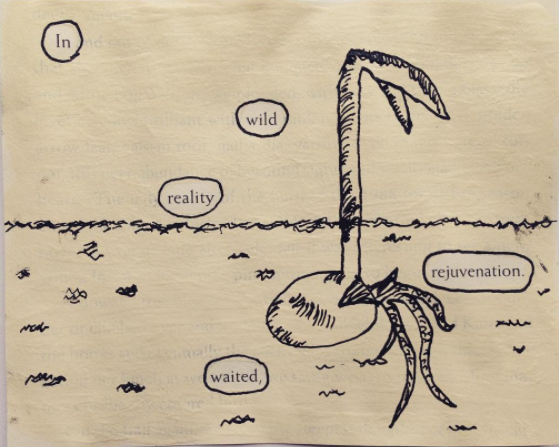
How to make blackout poetry
1. Gather some old written materials (books, magazines, newspapers, whatever).
If you have some books languishing around that you’ve been meaning to donate, grab them. Those are the PERFECT candidates for blackout poetry. Any type of book (fiction, non-fiction, whatevs) will do but the thicker the pages, the better. I’ve tried to use some flimsy mass-market paperback books and that thin paper tends to fall apart.
If you don’t have any books like this already on hand, check your local thrift store and spend a few bucks on a couple of random books. You could also use free printed materials you were going to recycle anyway, such as newspapers, junk mail, old magazines…you get the idea.
2. Select a blackout medium.
I had some old acrylic paint gathering dust in a closet, so that’s what I’ve been using to redact text. There’s something very satisfying about smearing paint across an old book page, but you could also use a sharpie, a crayon, a pencil, a pen, or anything else you damn well please. I mainly use just black and white paint, and many blackout poets stick to a monochromatic aesthetic. But if color floats your boat, get colorful! I just started experimenting with watercolor in my blackout poetry and I’m excited to keep playing around with various mediums.
3. Get any other optional materials ready: varying sizes of paintbrushes, pens, scissors, paper towels, pencils, and a hair dryer (to dry paint).
Written material and a blackout medium are really the core materials you need, but I’ve found my blackout poetry supply kit quickly expanding. I now keep all of the stuff listed above on hand. You might also want some newspaper or an old towel to throw down on your working surface just to keep unwanted messes to a minimum. I now have a growing pile of supplies, I keep them on my bookshelf so that I can grab them whenever the poetry whim strikes.
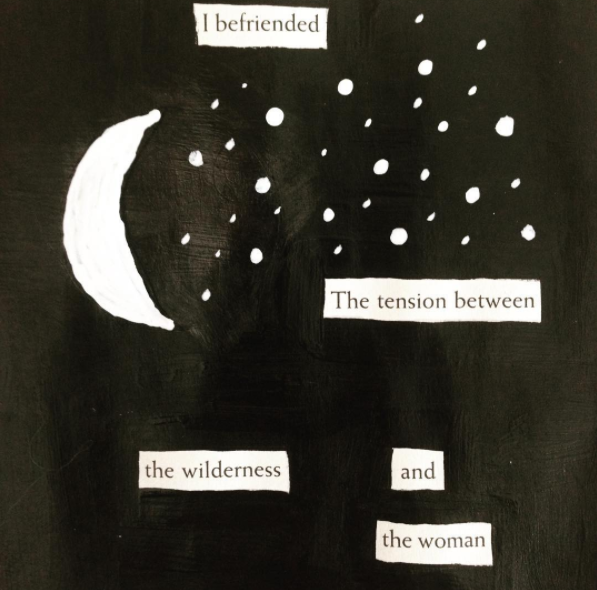
4. Choose a page and find the words that stick out to you.
In a strange way, blackout poetry pushes some of the same buttons as reading tarot. Try to trust synchronicity, flip to a random page and see what words you’re drawn to. I try to avoid reading the entire page straight through, instead looking at the page in a more abstract way, as though it is a kind of word farm. Let your eyes focus on various words until one sparks something within you. Then using that word as a base, jump to other random words and see how they connect. Before you know it, you’ll have fished out your own unique phrase.
Sometimes I “find” my poem right away. Other times I spend a while staring at the page, trying to puzzle something together. And other times still, I can’t seem to farm out the right words and so I turn to a new page. If you find yourself getting too frustrated, wait and come back later. Creating blackout poetry should be fun and feel natural. If it’s stressing you out, it’s defeating the purpose!
Your poem can be as short or as long as you want. You might want to fuss about aligning your words so the poem is easier to read, or you might choose words from all over the page. Don’t overthink it, trust what feels right. When you’ve selected the words that will make up your poem, circle them with a pencil.

5. Blackout the words that aren’t part of your poem, then add optional artistic flourishes.
Now you get to be really brave and start transforming your page. Rip the page out of the book so it’s easier to handle. Get your paint (or marker, or whatever else) and cover up the excess words. I have had the unfortunate incident of accidentally painting over words that I DID want in my poem more than once, so now I start by highlighting the words I want to keep. Then I cover everything else. If you want, you can then use a hair dryer to dry your paint.
Congratulations, you’ve now made a blackout poem! It’s as simple as that. Of course, there are all sorts of flourishes you can do from here. I like to add some type of drawing or embellishment to my poem. This adds a new dimension of creativity to your work, and it can also be another way to express the theme of your piece. In the example pictured above, the words of my poem say “the moment disappeared, space lost; unfinished.” I decided to add a clock, tying into the theme of fleeting moments. If I’m using black paint to blackout, I add my flourishes with white paint. If I’m using white paint to blackout, I use a ballpoint pen to add flourishes. In this example, the finished product looks like this:
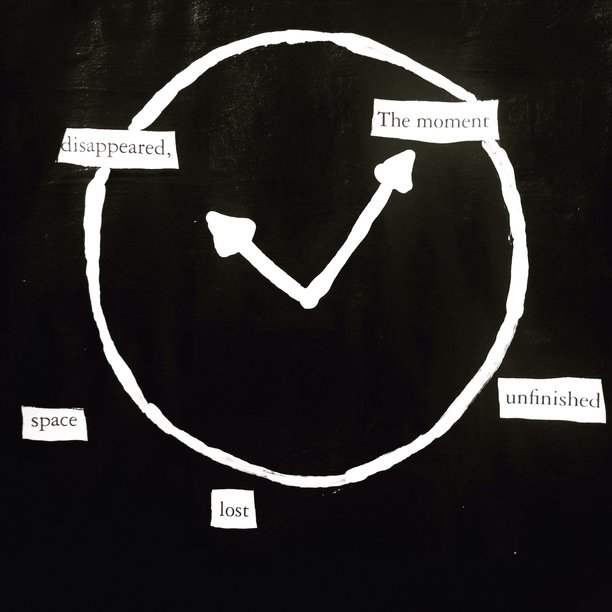
A few additional thoughts
When you’re done with a piece, you might want to write the date on the back. This way if you’re like me and go on a huge blackout poetry making expedition, you can look back on them almost like you would old journal entries. As with any other creative outlet, try not to fixate on how “good” your poems are or what other people will think about them. It can be really fun to share your pieces and I encourage you to do so if you want to (there’s a lovely blackout poetry community on Instagram). But it’s also totally cool to just have these be something you do purely to keep to yourself.
You’ll be amazed what you can glean about your current mental and spiritual state from your blackout poetry. Your unconscious mind is as influential in this process as your conscious mind. Above all else, blackout poetry is another adventurous way to explore the themes currently influencing your inner world. Try it!
And if you do share on Instagram, tag me (@carriemallon) so I can cheer you on.
Happy word farming,
Sign up for weekly updates and get the free ebook,
The Tarot Reader’s Daily Companion
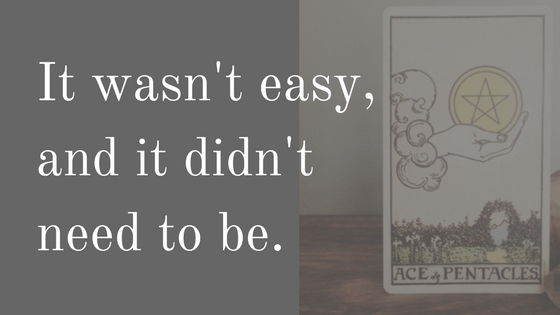
It wasn’t easy – and it didn’t need to be.
Hi there,
I BUILT MYSELF A NEW WEBSITE! AND IT’S NOW LIVE! YOU CAN LOOK AT IT RIGHT NOW!
I wish I could say that this project was full of serendipity and the universe supporting me…but it just wasn’t. It was really damn hard at times. And that’s okay. I’m going to talk more about that here.
I really loved my old website – but it had been more or less the same since 2014 – and in internet time, that’s more like ten years than three. The old site wasn’t particularly mobile friendly, and that really bothered me (and maybe you, if you ever tried to visit on your phone). This new site is compatible with any phone or tablet or new-fangled device!
I thought about hiring someone to build a site for me, but I gradually (and begrudgingly) realized the Universe wanted me to build it myself. I had a lot of resistance to this project at times. I would complain about working on the site. I would procrastinate working on the site. I would resent working on the site. I would set deadlines for myself and then fail to meet them.
the fuck down and say, “Carrie…my love…what is going on?
What’s the REAL root of all this resistance?”
As I sat with that question, I realized that I was resisting because this project wasn’t full of EASE. In fact, this project was often a royal pain in the behind. So many things went wrong: one time I spent a good hour getting something just the way I wanted it, only to realize none of my changes were saved. Another time, I spent hours and HOURS researching how to do something and NONE of the suggestions I tried worked.
At one point, I drew a couple of cards for myself about this project.
Out popped the Eight of Swords and the Moon, of course!
So yeah – this project wasn’t full of ease. It was often full of the opposite of ease – stress, frustration, and confusion.
The obstacles inherent in this endeavor were leading to my resistance, because I was telling myself a story that a lot of creative people tell themselves. It’s the story that goes “when you do what you’re meant to be doing, doors will open. The process will flow. You’ll be in the zone.”
This can be a useful story, to an extent. I certainly have had the experience of feeling that the Universe is supporting my projects and that things are flowing with magic and synchronicity.
But if you really devote to living a creative life, there will be times that a project nearly makes you punch a wall. Even the most meaningful creative projects can at times be difficult and trying. Even the project you most need to be working on – the project that has the potential to expand your soul – can seem at times like every freakin’ thing is going wrong.
I think this is one of the reason the Universe wanted me to build this site myself. I needed to be reminded of this truth. It’s something I already know, but I tend to forget:
Doing meaningful things does not guarantee that the road will be smooth at all times.
Sometimes we absolutely NEED the challenges and setbacks that pop up along the way, because that’s how we grow. Yeah, I get it, Universe. You don’t wanna let me just cruise through some things – you want to give me interesting puzzles to work through. Well played!
Now that my new site is live, I really could not be happier with how things turned out. Getting over the learning curve was brutal, but I now have a whole new web design skill set. When I look at this site, I feel like my energy, my love and my fingerprints are everywhere. I don’t know if I’d feel that so strongly if I’d hired someone else to build the site.
And perhaps the most valuable thing I’ve gained from this project is that reminder that doing meaningful, creative things is challenging. Growing pains are part of the process. If you only continue with projects that always feel easy and full of grace, you will definitely avoid some frustration – but you’ll also miss out on a lot of adventure.
That’s it for now – thank you so much for being here. I have soooo many things I want to create now that the new site is up. I feel like I’ve burst through to a new level of creative autonomy through this project, and I’m excited to continue to share things with you in this new energetic space.
Sign up for weekly updates and get the free ebook,
The Tarot Reader’s Daily Companion
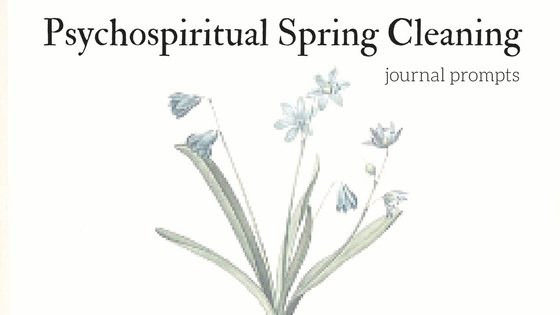
Psycho-spiritual Spring Cleaning: journal prompts
There’s something so compelling about organizing and prioritizing. As far as I’m concerned, ANY time life starts to feel clogged is a good time to do some (literal OR metaphorical) sweeping. And there’s something about spring – this season of renewal and rebirth and fresh starts – that lends itself particularly well to cleaning.
I’ve been thinking a lot lately about what needs refreshing in my own life. Just like our physical environment gets dusty and needs regular attention, so do the other dimensions of our lives. With this esoteric thought in mind, I’ve created a set of prompts you can use to do some psycho-spiritual spring cleaning for yourself. Of course because I’m me and tarot is life, there are four sections here, inspired by the four tarot suits.
I hope that these prompts will help you shine a light on some areas of your life that could use some sprucing up. I would recommend using these as journal prompts, if you’re into that kind of thing. This isn’t just about cleaning and purging – although there’s a bit of that thrown in! This is mostly about clearing away what is dusty so that you can really focus on what’s important.
I hope you will find this exercise useful!
Write down one word that describes the most prominent emotion you’ve had so far this year. Now write down one word that describes the emotion you’d most like to be feeling. Do they line up? If not, how might you bridge the gap?
Who have you been missing? Name at least one person. Reach out to them. Challenge yourself to be a little vulnerable and let them know how much they mean to you.
Whenever you have a memorable or powerful dream this season, write it down. At the end of the season, reflect back upon these records. What lessons are your dreams presenting?
As you go about your days, look for “unexpected gratitudes.” Each day, take note of at least one “weird” things you are most thankful for.
List three near-by places you’ve been meaning to explore; such as parks, cafes, bookshops, forests, lakes etc. Now make a plan to actually visit those places this season.
What are four things you’ve done this year that made you really happy? Can you do them again soon?
What is one errand, chore or task that you’ve been meaning to do but haven’t gotten around to yet? Make a plan to JUST DO THIS and just get it out of the way ASAP.
What creative acts have been calling to you? For the next month, try to set aside at least one hour per week for creative play time. Remember that this is for YOU, not to create things to show to other people – just creating for yourself.
List three items you own that are taking up unnecessary energetic and physical space. Where can you recycle, donate, or purge these items this season?
How can you be more attentive to the wonders of your five senses this season? Can you further incorporate some of your favorite smells, sights, textures, tastes and sounds into your daily routine?
What is one concrete action you can take to make life better for someone else this season? Can you help a friend in need, donate to a cause you care about, volunteer your time, or help the world in some other way?
Describe one simple action that improves your quality of life. This might be eating vegetables, walking, writing, reading, laughing, etc. Each day this season, try to make space for that action in your life (even if it’s only for ten minutes).
Where in your life have you been avoiding making a firm decision? Make time this season to give this situation full consideration and make a proper choice.
Take note of which situations in your life currently make you the most stressed and frazzled. How can you quit, rework, or reframe your perspective on these situations?
Under what circumstances do you feel the most calm and collected? For example: meditation, being in nature, etc. Are you doing these things regularly? If not, how can you start?
Start a “release jar” for your worries: whenever you experience fearful, anxious, harmful thoughts or worries, write them down and place them in a mason jar with the word “Release” written on it. This is a way to symbolically liberate your energy by releasing your worries to the Universe.
Happy spring cleaning,

Book a private reading with me here.
Sign up for fresh blog posts weekly + my free ebook ‘The Tarot Reader’s Daily Companion’.
Sign up for weekly updates and get the free ebook,
The Tarot Reader’s Daily Companion
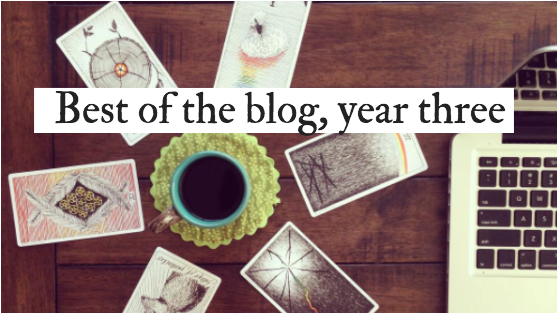
Reversed cards, Flash Fiction and more: Best of the Blog Year 3
As I’m writing this, it’s the spring equinox here in the northern hemisphere – and I am FEELING IT. Sometimes the energy in mid-March feels even more ripe with potential than the new year in January does, don’t you think? This time of year has grown a particular importance to me because it’s my blog and biz anniversary! I have now officially been doing this whole tarot reading and writing thing for three years!
Since I put up blog posts almost every week, making your way through archived posts can be quite the adventure. Each year when I hit my blogiversary, I go through all the posts from the last year and put together a “best of” list; a collection of posts that seemed particularly well-received by some of you guys.
If you’re new to my blog or if you just wanna check out some interesting stuff you might’ve missed this year, here are the best posts from year 3!
The healing process: pain is required
The Devil, The Tower and the Star launch a discussion about emotional and spiritual healing.
One tip for intuitively connecting with your tarot cards
Seriously, THE number one way to strengthen your intuitive understanding of tarot cards.
Unpacking the “I’m not good enough” fear in business
For current or aspiring business owners: let’s deconstruct any notions that you’re not good enough to do this.
How to read reversed tarot cards
To reverse, or not to reverse? Plus a few key ways to interpret reversed cards.
Refer to this when you need reminders of what’s important
Crucial reminders for anyone wanting to live more authentically and creatively.
How to create your own Memento Mori with tarot
Remember, you will die!
How to get the most magic from an email reading
Before you purchase another email reading, read this and you’ll get the most goodness possible from the experience.
Write your own tarot flash fiction
There are so many unique ways to use tarot. Here’s one of my faves that combines introspection and fiction writing.
If you’re so inclined, take a peek at the best of the blog year one and year two, as well.
Thank you so much for spending any amount of time with the stuff I create. It really means a lot to me.

Book a private reading with me here.
Sign up for fresh blog posts weekly + my free ebook ‘The Tarot Reader’s Daily Companion’.
Sign up for weekly updates and get the free ebook,
The Tarot Reader’s Daily Companion
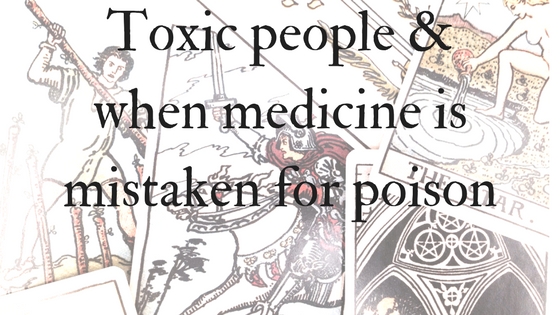
When toxic people are healers (medicine mistaken for poison)
If you’ve spent any amount of time scrolling through the self-development sphere on social media, you’ve probably encountered memes instructing you to cut toxic people out of your life. As well meaning as these posts are, they often over simplify something which is usually, in practice, quite complex.
Consider first of all how you define a toxic person. Someone who outwardly sabotages you? Someone who belittles you and drags you down? Someone who just sucks the energy right out of you? Perhaps most importantly, WHY does this person have this power over you? What is the root of the extreme reaction you have to them? In essence, it’s important to define exactly what makes you perceive certain people as toxic. And really getting clear about why someone is toxic to you usually requires you to do some not-so-easy work on YOURSELF.
Because one common thread that runs between the people you define as “toxic” in your life is that they they trigger you. They have an energetic key that releases your demons. This makes you feel unsettled, upset and rattled. This unpleasantness is why so many people share messages promoting cutting ties with toxic people. We don’t want to feel unpleasant, and sometimes we’d rather kick someone out of our lives than feel icky.
The other thing about toxic people is that they are rarely ENTIRELY toxic. As Martin Luther King Jr famously said, there is some good in the worst of us and some bad in the best of us. The same person who sometimes inspires, uplifts and supports you might at other times infuriate you. In fact, it seems to generally go that the closer we are to someone, the more hyper-aware we are of their toxic traits. We get pretty intimately acquainted with the toxic aspects of our lovers, close colleagues, dear friends and family members. Since these “toxic” people are often so engrained in our life, totally cutting them out isn’t always the solution.
I’m not saying that there’s no instance in which the best way you can support yourself IS by cutting ties with someone. There are times when you’ll find that you’ve tried everything you can to learn from certain people, but their presence in your life is too destructive. For the love of everything, yes, please DO cut out toxic people if and when you know it is the best choice to make.
But there are other instances in which the best way you can support yourself is by exploring your inner darkness that this person draws out. Toxic people can be your greatest teachers, sometimes, believe it or not. Sometimes a certain person’s bullshit is the only thing that gets you to finally confront your own unconscious bullshit. “Toxic” people can be paradoxical healers – it’s just that you might at first mistake the medicine for poison.
Toxic people show up and shake up your inner landscape up – it’s by going right through that ruckus (not avoiding it) that you develop a more secure and stable foundation. The more willing you are to confront the fuckery a toxic person is drawing out in you, the more unfuckablewith you become.
Here is a tarot spread to help you explore the lessons a toxic person is teaching you:
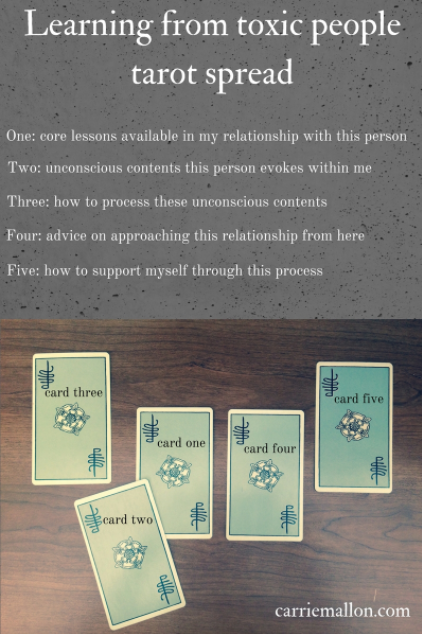

Book a private reading with me here.
Sign up for fresh blog posts weekly + my free ebook ‘The Tarot Reader’s Daily Companion’.
Sign up for weekly updates and get the free ebook,
The Tarot Reader’s Daily Companion
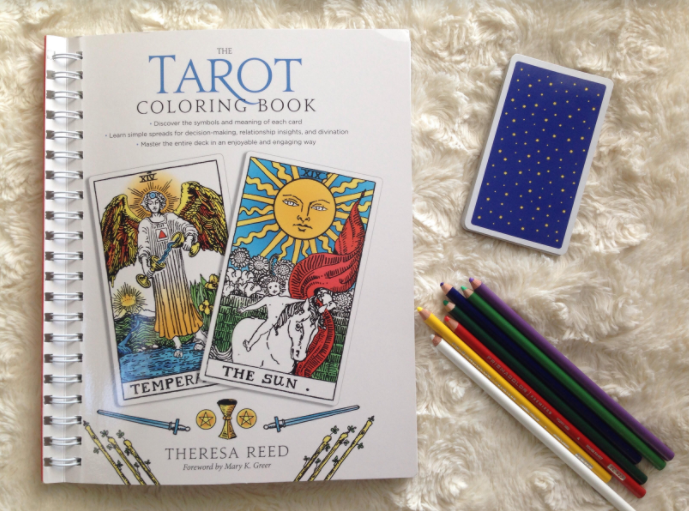
The Tarot Coloring Book: a review (and a giveaway!)
It’s hard to decide what to focus on when I talk about the Tarot Coloring Book. First, there’s the simple fact that it is a TAROT COLORING BOOK. That alone would probably have been enough to hook me. But wait, there’s more! It was written by Theresa Reed (the Tarot Lady), a beacon in the tarot community. And then there’s the multiple awesome things I’ve experienced while working with this book: a reinvigorated relationship with the cards, a mindfulness meditation, and a fresh creative outlet.
I’m going to tell you about this book today, and I have a copy to give away to one lucky person! Details on that at the end of the post.
The Tarot Coloring Book starts with a brief introduction that touches on the history of the cards and how to work begin working with the tarot system, making the book suitable for total beginners as well as seasoned tarot readers. At the heart of the book, all 78 cards from the Rider Waite Smith Tarot deck are presented in black and white. Each card is accompanied by a summary of the meanings and symbols.
How you approach things from here is entirely up to you. Perhaps you’ll want to use a traditional deck as a reference, using similar colors to the originals. Or maybe you’ll want to buck tradition and go for psychedelic purple skies. Whatever floats your boat!
At the risk of sounding like a total Hierophant, I’m choosing to stay close to the original colors. This is because the Tarot Coloring Book is one of the most efficient tools I have found for deepening a relationship with the Rider Waite Smith deck. A while back, I made a video describing the number one exercise I recommend to strengthen your connection to your tarot cards: going through one card at a time and describing every single detail you see. This is what the Tarot Coloring Book forces you to do – you are required to observe every angle of every card as you infuse them with color. If you are looking for a really engaging way to continue your tarot studies, you can’t beat this one.
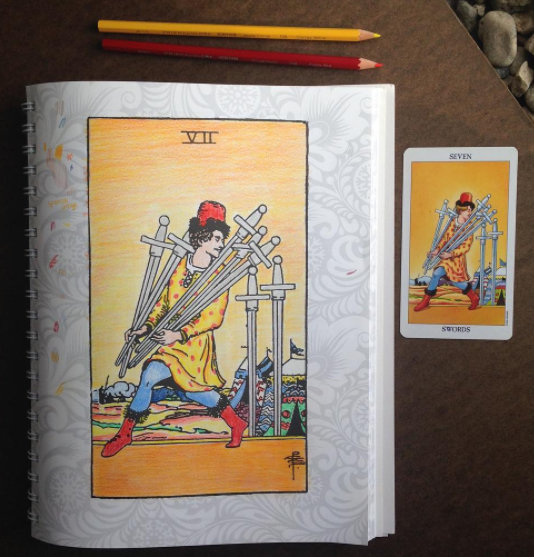
Before I got this book, I was aware that coloring for adults has been a sort of mindfulness trend lately. I’d found myself browsing the coloring section at book stores and running my fingers over boxes of colored pencils, but I never ended up trying anything until now. As it turns out, the Tarot Coloring Book came into my life at a time when mindfulness was more of a challenge for me than ever (right after the US presidential election).
Cozying up to color tarot cards has now become a sacred space for me. My brain’s usual constant rumble of thoughts start to slowly even out as I select hues of pink, green and yellow. My inner state becomes more focused and spacious as I press pencil to paper. I experience that harmonious state of being present with the now, engaging my mind as fully as possible with the task at hand. It doesn’t sound like much, but it’s probably as close as I will ever come to being a zen master.
The Tarot Coloring Book has also asked me to activate my sometimes neglected sense of visual creativity. Most of my creative work involves words: writing blog posts, writing interpretations of tarot spreads, writing social media posts and so on. Coloring asks me to shift into a different creative mode, one that doesn’t always feel natural for me but does feel exciting and magical.
As I described earlier, this book has proven to be effective for me on multiple levels. Even after years of working with the Rider Waite Smith deck, I’m re-imagining the imagery. During a period of turmoil in the outer world, I’m finding a more solid connection with my inner world. The Tarot Coloring Book lives in that sweet space between serious self-discovery and serious fun – and that’s a space I really enjoy visiting.
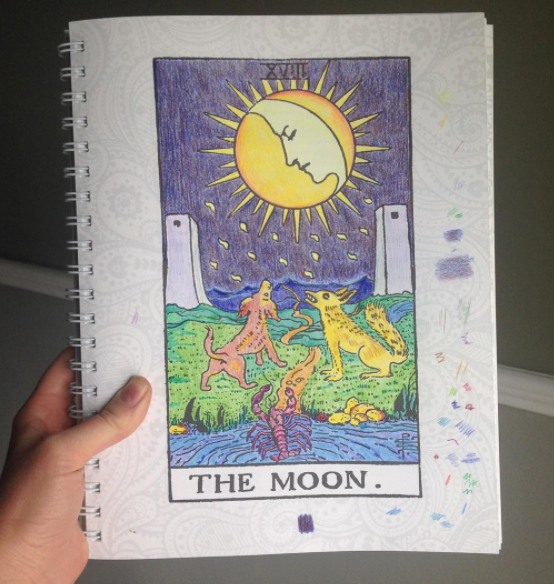
Giveaway time! I’m not even going to ask if you’d like to win a copy of The Tarot Coloring Book because of course you would. This one is only open to US residents (so sorry my worldwide friends! Shipping costs, ugh). To enter, all you’ve got to do is leave a comment on this blog post. So easy. I’ll draw a winner at random on Saturday, March 11 at noon Mountain Time.
If you want to cut to the chase, you can purchase your Tarot Coloring Book through Sounds True
or Amazon.

Book a private reading with me here.
Sign up for fresh blog posts weekly + my free ebook ‘The Tarot Reader’s Daily Companion’.
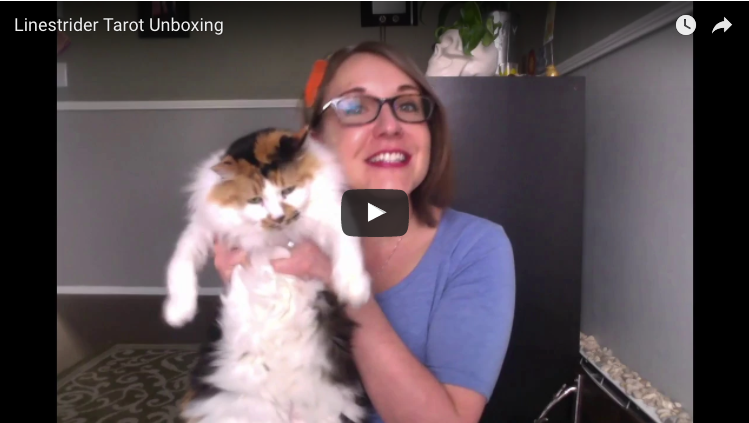
Unboxing the Linestrider Tarot
One of the more dangerous things about my habit of browsing endlessly through Instagram is the ease with which I discover new tarot decks. It was during one such session of looking through my Instagram feed that I first stumbled upon the Linestrider Tarot.
The use of white space, nature elements, and the somewhat surrealist imagery caught my imagination. The deck’s creator, Siolo Thompson, describes linestriding as “walking in two worlds – one foot in each to discover guidance.” Umm, sign me up!
There was a time when I bought decks willy-nilly, but these days I have learned to somewhat reign myself in. I have my tried and true working decks, and in order for me to buy a new deck now it has to really speak to me. This is what I told myself when I first saw the Linestrider Tarot, and I did manage to hold off purchasing one for quite some time.
But alas, after the holidays this year I decided to treat myself to a couple of new decks, including this one! And in this video, you can see me unboxing the deck for the very first time and sharing my initial impressions. Upon first glance, there are some things I love in this deck…and there are some things that make me go WTF?! Riveting, I know! Check it out:

Book a private reading with me here.
Sign up for fresh blog posts weekly + my free ebook ‘The Tarot Reader’s Daily Companion’.
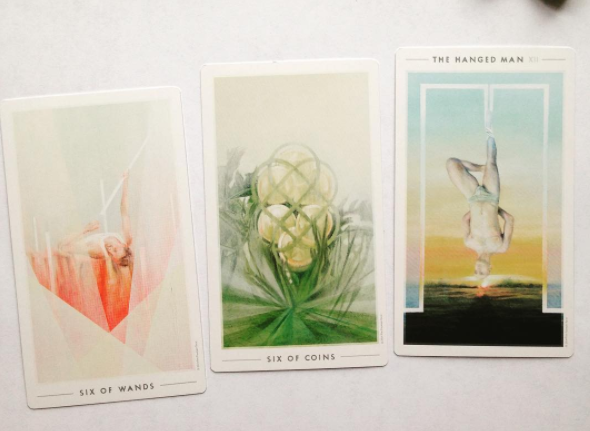
Tarot just bitch slapped me about my upper limit problems
A couple of days ago I felt inspired to give myself a reading with the Fountain Tarot. I didn’t have a set focus area, I just had this strong intuitive sensation that I’d get a really powerful message. I turned over my cards, expecting to have an instant connection with the insight they would bring forward.
I drew the Six of Wands, the Six of Pentacles, and the Hanged Man, all in reverse. I turned the cards around, telling myself I wouldn’t use reversals since I’m still getting used to this deck (I later realized this was a mistake – the cards were reversed for a reason).
Uhhmmm…well, at this point, my intuition broadcast crickets. I stared at the cards, running over various textbook interpretations in my brain, but nothing seemed right. I felt disappointed – when I get that sensation that a reading is about to be really powerful, it’s never been wrong before. But I thought maybe this time it was.
This gave me an unsettled feeling. My rational mind assured me that this was all because I was working with a new deck, but deep down I felt like there was SOMETHING right in front of my face that I was missing. I even put the call out on Instagram to have people chime in with their thoughts on the reading! I got relevant and helpful comments there, each of which served as a compass to point me closer to my own understanding, but I still wasn’t quite there.
The next day, as I was preparing breakfast and not thinking about tarot whatsoever, the message from this reading suddenly CAME to me, crystal clear: I’ve got an upper limit problem.
There is a book about this topic, I haven’t read it (yet). But here’s my understanding of how this works: we all have an unconscious limit of how much “good stuff” we think we deserve. When we start having some success that approaches these unconscious limits of what we believe we should receive, we halt our own progress without realizing we are doing so. We start sabotaging ourselves, effectively suspending our ability to make further progress.
Well, holy damn fuck. THIS is what the cards were trying to tell me: The Six of Wands showed some of the good stuff and success I’ve recently experienced. The Six of Coins showed how I’ve been pressing up against my own limits of how much good stuff I’m capable of receiving. And the Hanged Man showed how this has put me into a pattern of stasis. The reversals hinted at why I had such a hard time circling in on the message – my conscious mind was still resisting acknowledging that this has been happening.
Once I’d been smacked over the head with the revelation that I’m experiencing an upper limit problem, so many things made sense. Here’s just one example.
When I offered my New Year tarot readings at the beginning of the year, they sold really well. Like, WAY better than I expected. It was awesome and amazing, and I was so grateful. I was riding the high of success, doing the work that I love to do, and feeling like my business was reaching a new level of goodness.
But then, during the last week of completing my purchased readings, I got sick. I hardly ever get sick, and when I do it usually just lasts a couple of days. But not this time! Nope, I was knocked completely on my ass for several days, and even once I could function again it took an entire MONTH before I was back at 100%. This lingering illness made it so I was incapable of taking the momentum at work in my business and channeling it into further good stuff.
Now, I’m not saying that colds aren’t caused by germs and whatever else. But I can’t help but believe that this lingering illness was linked to my upper limit problem. At an unconscious level, I saw that I was succeeding, and that success was getting too close to my unconscious allocation of what I deserve. And so I got sick, in order to stay in my status-quo level of success.
Your unconscious upper limits are established in various ways. They might be influenced by your innate personality, the things you learned from society as a child, your fears and ego, your karma, and so on. Considering where your upper limits come from can certainly be useful, but it’s even more useful to focus on how you can move through them.
I’ve encountered upper limit problems before and managed to transcend them. But the thing about upper limit problems is that they tend to just keep on coming. It’s kind of like leveling up in an endless video game. You pass one level boss, but then you have to get past another, and another, and another. That’s how upper limits are.
Realizing that you have an upper limit problem is only the first step – but it’s a pretty powerful step, and sometimes it’s actually the HARDEST step. Now that I’ve completed this step (go me!), here’s how I’m planning to proceed.
I’m going to start by continuing to make my unconscious upper limits known to my conscious mind. This will happen through journaling, more tarot pulls, dreamwork and meditation. Once I have greater clarity about what my current limits are, I will continue the work to rewire them. This happens through affirmations, energy work, and catching myself in self-sabotage and redirecting my behavior.
Working through upper limits, like any type of self-discovery process, is complicated and unique to us as individuals. It’s a tough road to travel, but it’s the road that leads to a more meaningful, empowered and magical life. And so here I go, devoting to that road once again.

Book a private reading with me here.
Sign up for fresh blog posts weekly + my free ebook ‘The Tarot Reader’s Daily Companion’.
14 questions to ask yourself (and your cards) about love
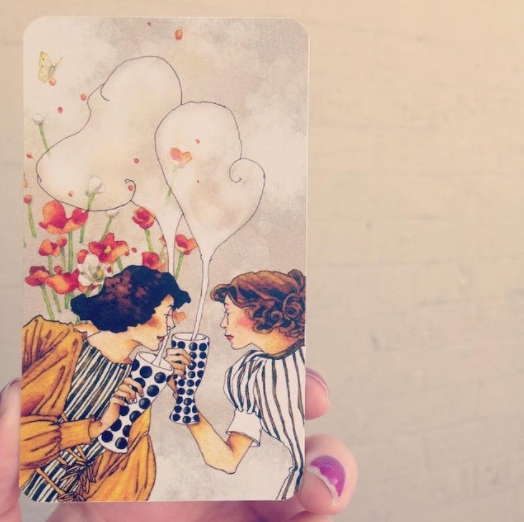
Dreaming Way Tarot
So, to be honest, I’m not that into Valentine’s Day. But I AM into the concept of LOVE! You know, though, love is a complicated and open-ended topic. On Valentine’s Day we tend to focus more on romantic love, but it’s important to also consider the more expansive implications of love. This can be tricky to do, though, as we don’t even have one set “definition” of love to get the inquiry going. Exploring your relationship with the concept of love sounds worthwhile in theory, but where to begin?
With this query in mind, I came up with a list of questions to inspire you (and me) to explore the concept of love, using tarot as a prompt. To get the most out of this exercise, I suggest drawing cards AND journaling on each of the questions. I’m going to be drawing cards at random for these prompts, but you could also consciously select cards to answer each question, if you’d prefer.
I’ll share my cards and thoughts with you here, but of course yours will likely look quite different from mine. Love does not have one fixed definition, we are all touched by this concept and interact with this concept in different ways. I hope you’ll try this for yourself and that these questions might give you a more holistic understanding of your relationship with love.
What can help me define love?
I drew the Three of Wands.
Love is the force that gently draws me forward. Love invites me to explore the world, to explore my own psyche. Love is what keeps me facing the sun, facing possibilities. I can define love as the energy that points me towards what is interesting and powerful and worth discovering in this life.
How can I increase my ability to receive love?
I drew the Three of Swords.
Love and pain are intrinsically linked. If I want to receive love in deep and profound ways, I have to accept that I will also receive pain in deep and profound ways. When I try to filter out pain and only receive love, I weaken my ability to perceive any emotions. As Khalil Gibran said: the more deeply that sorrow caves into your being, the more joy you can contain.
How can I increase my ability to give love?
I drew the Five of Wands.
Instead of being nit-picky, I can work on accepting and loving people for who they are. It’s important for me to check my tendencies to lash out at the perceived flaws I see in other people. To give more love, I need to accept that sometimes the people I love the most are also the people who can really drive me nuts. People are not only deserving of love when they live up to some idealized version of themselves that I’ve built up in my head. Instead, I can give more love by being willing to give love even when I perceive people as being difficult and annoying.
What might stand in the way of love?
I drew the Five of Cups reversed.
Unconscious feelings and beliefs telling me that I am not worthy of love stand in the way of love. The fear of sadness, the lengths we got to avoid sadness – these things are more effective barriers to love than the actual sadness itself. Sometimes despair can feel very pressing, the experience of despair can be so visceral that it seems as if love will never again break through. But love always does break through, and is present even as a barely discernible undertone even when despair feels utterly prominent.
What is unexpected about love?
I drew the High Priestess.
Love is a great shapeshifting mystery. There is more that is UNEXPECTED about love than that which is expected. Love deftly moves beyond expectations. Love is not restricted to cliches or traditions. Love is a pulse, a heartbeat in my individual consciousness that mirrors a pulse in the universe itself. How this pulse manifests is infinitely variable, and almost always unexpected.
How might hurt and love be reconciled?
I drew the Two of Pentacles.
This echoes the themes brought up by the Three of Swords. Hurt and love must coexist. One cannot be banished without dragging the other one along. I can work on consistently evaluating how I am managing both of these energies. I can become more aware of which I am paying more attention to in a given moment, I can attempt to ensure that they are working together instead of at odds within me.
In what ways has love transformed me?
I drew the Six of Swords reversed.
Love has taken me to hell and back. Love has thrown me for a loop. Love has led me to great confusion and powerful insights alike. Love has asked me to go beyond the peripheries of my own awareness and consider the greater linking of all things. Love is taking me for a ride, and that ride is called life.
How has my understanding of love evolved?
I drew the Nine of Wands reversed.
Without realizing it, I used to approach love with great caution. I didn’t want to bring too much of myself forward. I didn’t want to risk getting hurt. And so I showed up in measured ways, cautiously assessing the situation. Instead of letting myself tune into my true self and softly unfold, I approached love with calculated strategy. I didn’t know I was doing so.
Now, my understanding has evolved. Love is not about avoiding parts of myself. Love is not about presenting a facade. Love is not about carefully measuring out how much of ME to bring to the table. Instead, love is about liberation. Love is about expression. Love is about being who I am, being open and curious about who others are, and leaving room for things to continuously expand and evolve.
What masks look like love – in other words, what might be mistaken for love?
I drew the reversed Ten of Cups.
Love wears the masks that society has placed upon it. Society says that love is about marriage, children, white picket fences. And of course, sometimes love is vibrantly held within these definitions. But these things do not always reflect love. Love goes beyond definitions and structures. Love is boundless, showing up in all sorts of ways, moving to its own rhymes.
What unconscious emotions can love evoke?
I drew the Nine of Cups reversed.
Love can lead me to a more direct understanding of what I really want. Love asks me to sit with what I think I want and see how that lines up with what actually makes me happy. Love asks me to consider what I thought would bring me fulfillment verses what actually DOES bring me fulfillment. In this way, love is a teacher that brings me into a more refined and nuanced understanding of the emotions lurking beyond my surface.
Where is the need to love MYSELF more consciously?
I drew the Eight of Pentacles.
Lately, I’ve been working to love myself in very concrete ways: by eating lots of vegetables. By engaging in the activities I really care about. By working on my business. By keeping the promises I make to myself. I can show myself love through my direct actions, by approaching these things with not a sense of duty but a sense of devotion.
Where is the need to love OTHERS more consciously?
I drew the Ace of Pentacles reversed.
Sometimes it feels awkward to reach out to others. I do often fall into the trap of wishing someone else would take the initiative. It can make me uncomfortable for me to take the first step, to set the plans, to be proactive. But by being willing to be the instigator, by showing a concrete commitment to keep up connections, I can bring more consciousness to my love for others.
What beliefs about love should I re-evaluate?
I drew the Nine of Pentacles.
Love isn’t about appearances. Love isn’t about how lavishly someone praises me, or even how much they validate me. In fact, I often learn more about love from those who challenge me (as described with the Five of Wands). I can reevaluate any notions that love is supposed to keep me safely grounded in my comfort zone. Love is there to build me up, and the process of being built up doesn’t always feel comfortable.
How can I align more authentically with love?
I drew the Knight of Pentacles reversed.
Instead of focusing so intently on myself, on my own insecurities and issues…I can align more authentically with love by focusing more on others. By setting the intention to encourage those who need a boost. By remembering to let people be who they really are instead of who I suppose they should be. As I give other people the support to align themselves with love, I also give myself the ability to align with love.
If you answer these questions for yourself, I’d be quite interested to hear any insights you’d like to share. Feel free to leave a comment on the post and let me know.

Book a private reading with me here.
Sign up for fresh blog posts weekly + my free ebook ‘The Tarot Reader’s Daily Companion’.
Carrie Mallon
Header art from The Spacious Tarot illustrated by Annie Ruygt
All site content © Carrie Mallon LLC 2014-2019
Sign up for weekly updates

 I'm a tarot reader and mentor.
I'm a tarot reader and mentor. 